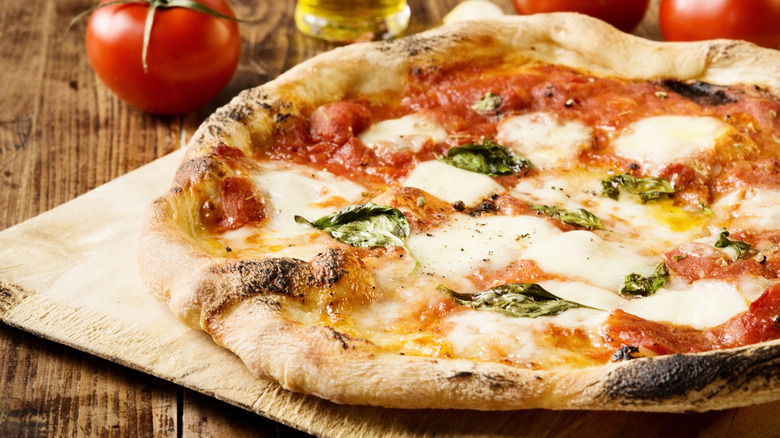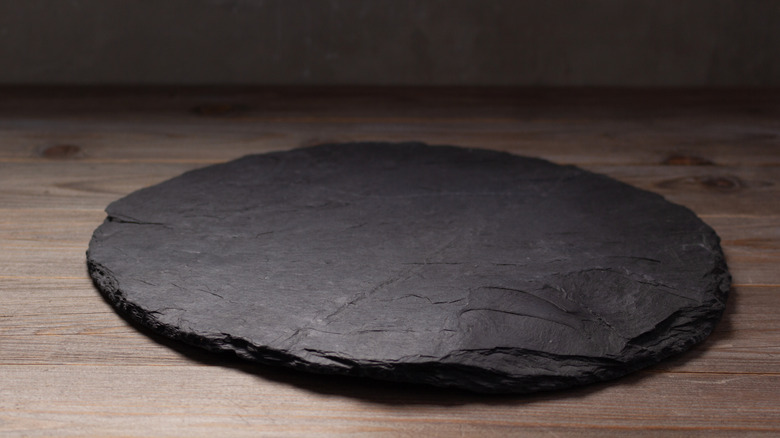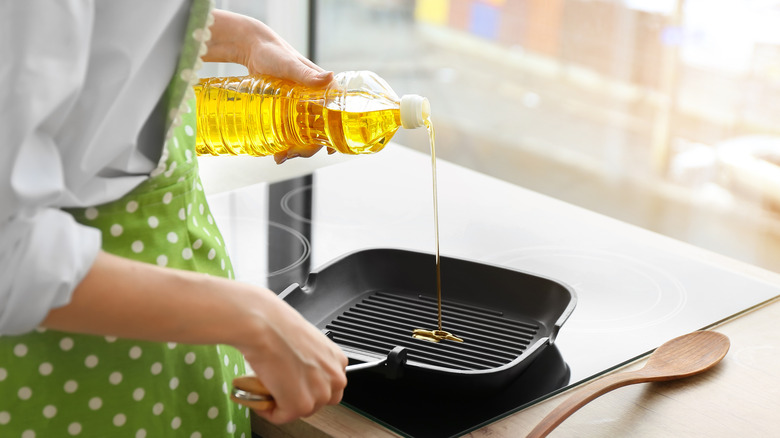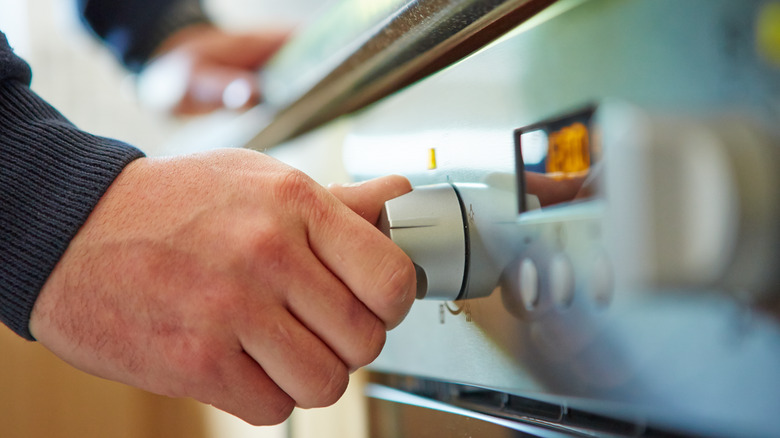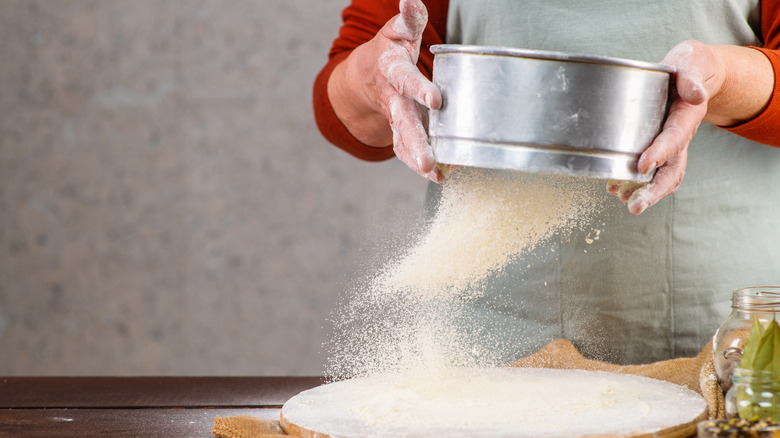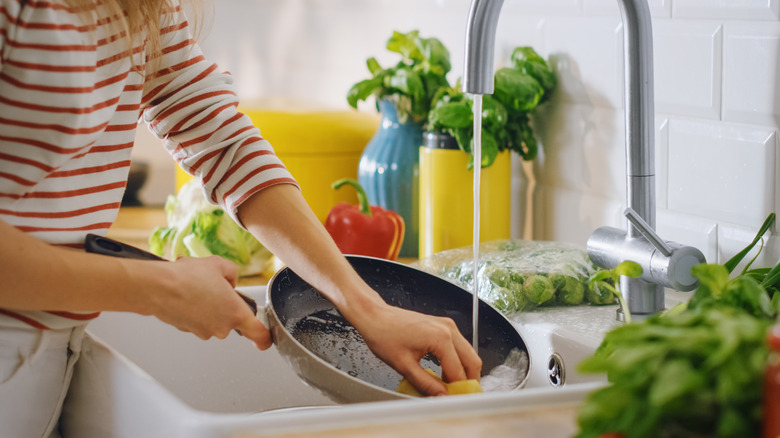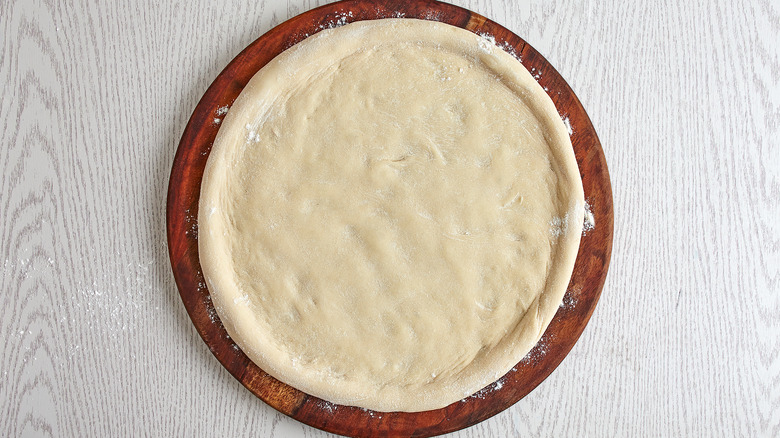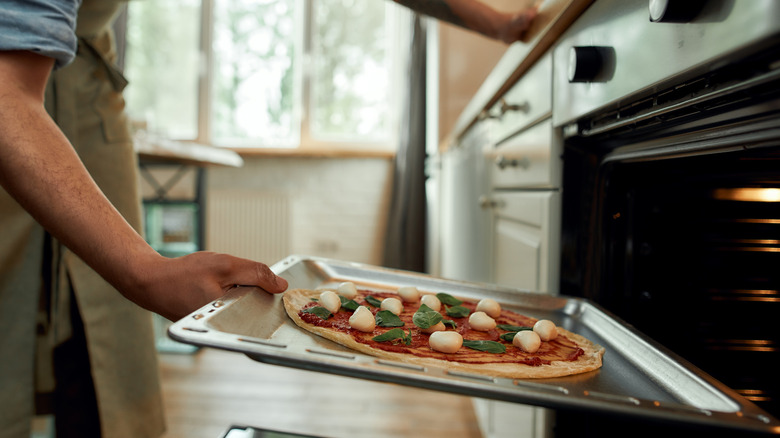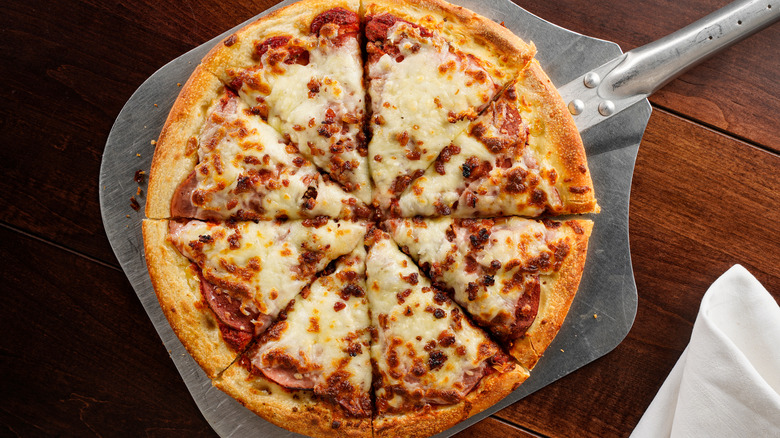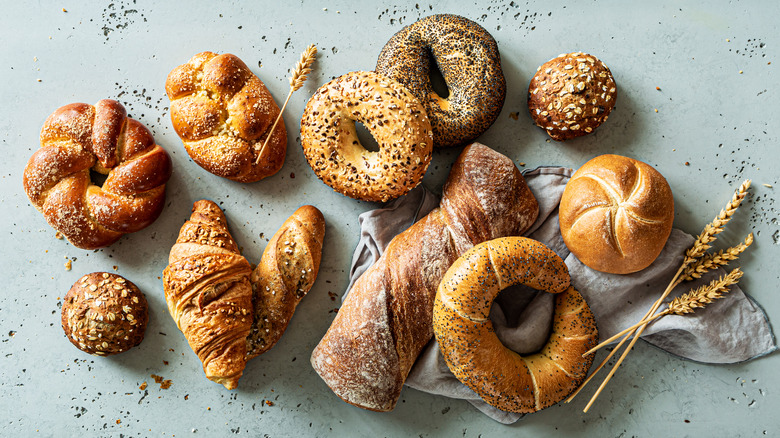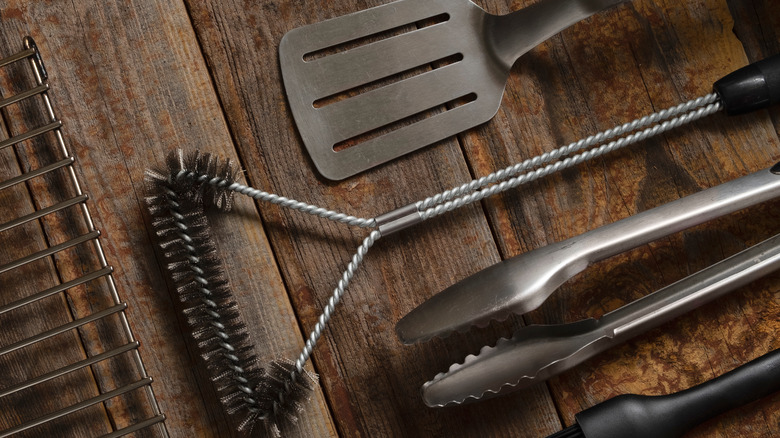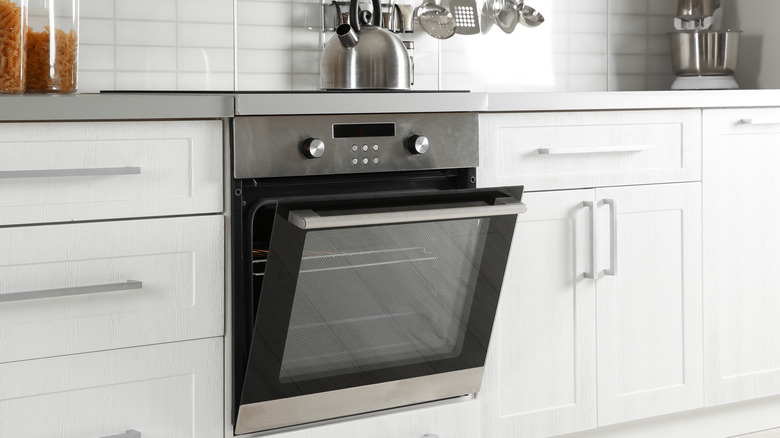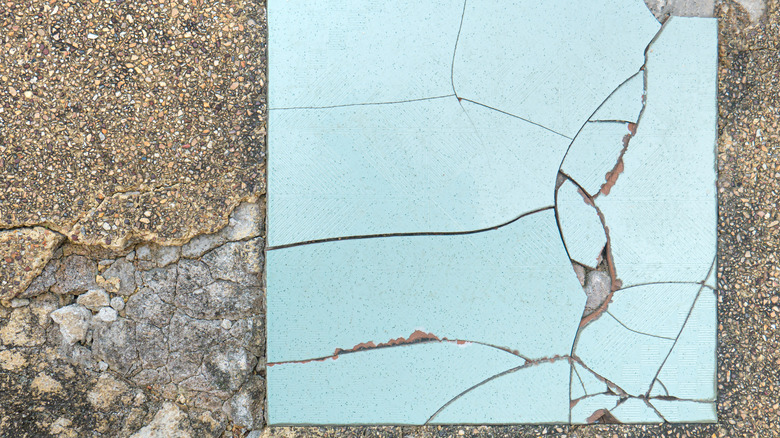Tips You Need When Cooking With A Pizza Stone
What's the secret to the perfect restaurant-style pizza? The best crispy crust that holds up to sauce and toppings while still being tender. While it may seem hard to believe that you can achieve the same results as your favorite pie joint, the fact of the matter is, pizza is a fantastic dish to make at home. Beyond great toppings and the best sauce, the crust is often what causes the most issues when trying to bake a pie at home.
Luckily, the answer might be an easy fix you haven't thought of. Even without a custom wood-fire grill, there's a way to get a crispy crust at home. Enter, the humble pizza stone. Though sticking a piece of stone in your oven might not be your first idea, using a pizza stone is a surefire way to get restaurant-quality pies — as long as you avoid some common pitfalls first-time pizza stone users might face.
Purchase a quality pizza stone
When it comes to finding the right tool for you, the term "pizza stone" might be misleading. Also sold under the name baking stone, or pizza steel, pizza stones aren't actually stone; they're stoneware, a specific type of clay. Like hot tiles in the sun, pizza stones hold in heat, making them perfect for getting wonderful browning and even heat distribution.
Pizza stones are available from many sources, but make sure you buy from a reputable manufacturer. Your pizza stone should come with instructions on how to best use and care for it, and most manufacturers offer their information online for easy access. From rectangles to circles, brightly colored glazed pieces, or simple slate sheets, there's a pizza stone that's perfect for your oven available.
Can't find one you like? You can try making one yourself. Many home chefs swear by purchasing unglazed clay or porcelain tile from a hardware store and cleaning them thoroughly before usage. The tiles have to dry fully before you use them, and you should always be careful using supplies against their intended usage, but if finding a custom-sized stone is difficult, this could be an ideal alternative. Just be sure to inspect your stone regularly and avoid chipping and scratches.
Don't oil your stone
While some people swear by oiling stoneware used to bake bread in and follow a similar method to seasoning cast iron, you should never oil a pizza stone. Seasoning, or the process of baking a layer of oil into the surface of a porous material, is commonly used to make cast iron nonstick and to avoid rusting. If your pizza stone is rusting, that's a whole new can of worms. While cast iron benefits from a rub down of oil, a pizza stone will absorb any oil you may have used, which can lead to burning, and eventually opening your oven to a cloud of smoke.
Most manufacturers don't recommend seasoning your stones for this exact reason. According to leading bakeware manufacturer FibraMent, you should never season the stones with any type of baking oil. While every pizza stone is different, it's best to follow manufacturer instructions on how best to care for your stone. Many brands, and the chefs who use them, prefer the natural seasoning of a well-loved stone over a quick glaze of oil any day.
Preheat your oven
It's hard to think of something worse than a stuck or soggy pizza that tears when you go to remove it from the oven. Luckily, using a pizza stone tends to eliminate that problem. Pizzacraft, another manufacturer of iconic pizza stones, clarifies that when you cook your pizzas on a stone, you'll need to preheat the oven to at least 500 F with the pizza stone inside. The pizza stone itself should heat for at least 30 minutes before you add your pizza to the oven.
While that may sound like an excessive amount of time, it's worth it. Once the stone reaches such a high temperature, it retains its heat. That heat allows your pizza to go from raw dough to perfectly browned crust in eight to 10 minutes. By preheating your pizza stone, you also draw out any excess moisture that could turn your crust soggy and eliminate the chances of a thermal shock. By avoiding large jumps in temperature and keeping everything dry, you prevent your stone from cracking and your pizza from sticking.
Use flour on the stone
When you're trying to transfer a pizza to a blistering hot pizza stone, it can seem a little daunting. A common trick is building the pizza directly on a sheet of parchment paper and sliding the whole thing, paper and all, into the oven. According to Reynold's, a leading parchment paper manufacturer, its parchment paper is designed to withstand temperatures up to 400 F to 450 F. While those are high temps, you might see some charring on the edges of the paper when you crank your oven up to 500 F or use the broiler to get the caramelized melted cheese.
It should be fine to use parchment in a pinch or for easy pizza removal, but using flour can help avoid sticking and help you slide your pie in and out of the oven. Simply dust the pizza dough as you stretch it or dust the stone itself. If you're looking for the classic crunch found at the bottom of some of your favorite restaurants, Chef Nigella Lawson recommends using fine polenta, semolina flour, or cornmeal, all of which minimize sticking just as well.
Never use soap
While it may seem counterintuitive to avoid washing your tools in the kitchen, in this case, it's better to avoid it if you can. Because of the clay used to make stoneware, they're naturally porous. Never use soap on a stone! Pizza stones can absorb flavors from oils, soap, or even your ingredients. Beyond the unpleasant taste of a soapy crust, the detergents in most kitchen soaps will break down the naturally occurring seasoning that helps a stone do its job.
It's inevitable that things like fatty meats or oily cheeses will naturally fall onto the stone when you're using it to make pizza, but those can be dealt with by the high heat you use to cook the pizza, and any residual ashes can be wiped off, leaving a clean surface behind. Don't worry too much about staining and discoloration, both of which are natural the longer you use the stone. If there's a particular spot that's causing trouble or any residue that's starting to smoke in the oven, pizza blog Crust Kingdom recommends using baking soda to get rid of any burnt-on grime and unpleasant smells and tastes.
Use the right crust
If you're struggling with a dense doughy crust that never seems to bake properly, it may not be the fault of the stone. You may not be using the right dough for your pie. While deep dish pizzas are delicious, a pizza stone is best suited to a thinner crust that crisps on the outside and stays soft in the center. With how quickly you cook a pizza in the oven using a stone, using your favorite thick crust could cause an undercooked mess that burns on the bottom and stays doughy and raw underneath your sauce.
For store-bought pizzas, it may seem only natural to use a pizza stone to elevate a lackluster crust, but remember that thermal shock we talked about earlier? You wouldn't want to put a frozen pizza directly on the stone, as it can rapidly cool down the stone leading to breakage. Either allow your frozen pizza to thaw first, or use a baking sheet instead.
If you're noticing issues with your dough before it's even been placed in the oven, you could be over-kneading. Try a recipe for foolproof dough that requires minimal kneading.
Position your stone properly
If you're finding that your crust burns before your cheese melts or your toppings singe before your dough ever crisps, it could be an issue with your stone's placement. A pizza stone mimics a professional pizza oven, and to get the best use out of it, it's all about location, location, location. If you've got a broiler at the top of your oven, you'll want to make sure your pizza is lowered away from the heat.
On the opposite hand, if your broiler is at the bottom, you'll want to raise it slightly. Kitchenware supplier Crate & Barrel recommends your pizza stone not be placed on the top rack of your oven, and be positioned to allow at least 1 inch of space on all sides of the stone for airflow. If you're noticing that your pizza is cooked well but missing perfectly browned cheese and toppings, turn on the broiler for the last one to two minutes of cooking time. Because your pizza only needs to cook for eight to 10 minutes, sometimes an extra boost of direct heat is needed to completely cook toppings before service.
Use a pizza peel
Most pizza stones come with a pizza peel, a thin piece of wood or metal used to slide the dough onto the heated stone, or the option to purchase one with your stone. A pizza peel can make transferring your pie to and from the oven simpler and can cut time when you assemble the pizza. Stretch your dough to your desired size and place it on a pizza peel generously dusted with flour or semolina. Assemble the pie with your sauce, cheese, and desired toppings, then slide the pie into the oven, using the stone as your guide to perfect placement.
Using a pizza peel can seem unwieldy, but they often come in long and short-handled versions which can help avoid an unfortunate pie to the floor or ceiling. While they are useful, especially if you make a lot of pizzas, they aren't essential. They're great for pie aficionados, but you can substitute a peel for a cutting board, a baking sheet, or a flat plate without a rim to transfer your crust to the oven.
Try other recipes
While specialty cooking tools and equipment have their uses, the fact is, most of us don't have the storage to deal with tools that only have one use. If you're looking at your pizza stone in dismay, thinking that you couldn't possibly make enough pizzas to justify it, worry not. The way pizza stones retain heat makes them excellent for browning crusts of all kinds. Try making crackers, homemade pretzels, or loves of bread, all with perfectly golden exteriors.
While you can cook things other than bread and crusts on your stone, you risk introducing other flavors or oils to the stone. Things like meat and fish may get an excellent sear, but they can also leave behind fats and oils. Once these are absorbed into the stone, there's always a chance they could burn or go rancid. Really, anything with a lot of fat or pungent smells is likely a no-go. Best to cook those ingredients on top of crusty items like flatbreads, pies, or tarts, like this peach galette.
Scrape your stone
We've said it before and we'll repeat it, but you should never use soap on your pizza stone. Water isn't as bad, but every time you add moisture to your stone, you'll want to make sure it's completely dry before you try to bake with it. By introducing excess moisture to your pizza stone, you risk the stone molding or cracking when steam escapes from it when you next go to cook with it.
To avoid all of this, use water only when absolutely necessary. If you must, don't run water over the whole stone, and use a damp rag to spot clean. For anything like crumbs, sauce spills, or burnt-on cheese, pizza restaurant Giordanos says it's best to scrape your stone. Use a rigid plastic scraper or spatula after the stone has cooled to lift off any gunk. Once you're done, you can use a stone-safe brush, or a grill brush in a pinch, to sweep away the lifted leftovers.
Keep your stone in the oven
You know how to use your pizza stone, and you know how to clean it (No soap! Seriously!). But how do you keep your stone in the best condition possible? Keep it in the oven. According to America's Test Kitchen, by keeping your pizza stone in the oven, you minimize the chance of dropping it or exposing it to different temperatures.
Beyond the obvious plus of not having to worry about finding a place to store a hot stone after using it, keeping the stone in your oven has some other bonuses. Even when you're not using the stone itself, having the stone in your oven helps regulate the heat inside the oven and can help you cook more efficiently. By minimizing hot zones and keeping the temperature even, you won't have to worry about changing temperatures while you bake things that require a long, low, and slow process.
Avoid cracking
There's nothing more devastating than a cracked pizza stone. It can happen for a few reasons, namely extra moisture, drops, or extreme temperature changes. There are plenty of DIY pros who offer ways to fix a broken stone like heat-safe adhesive, rubber cement, and other options that can be found online, but, according to Castelegance, a pizza-specific stoneware retailer, the best idea is to pause. If the stone is still too hot to handle, wait until it completely cools to assess the damage. The stone could have cracked along the edge and the majority of it is still perfectly fine to use.
If your pizza stone split down the middle, however, it may be more effective to purchase a new one. By trying to glue the pieces back together, you risk the glue melting in your oven and causing even more of an issue, and your stone now has a point where the heat won't conduct as easily. Take a deep breath, steel yourself, and look for your replacement. A cracked pizza stone is just a reason to experiment with new recipes and a chance to build up a brand new layer of use on a new stone.
